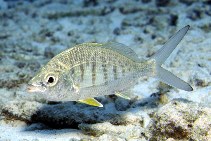http://www.fishbase.org/Summary/speciesSummary.php?genusname=Gerres&speciesname=cinereus ---> http://52.67.158.155/Summary/speciesSummary.php?genusname=Gerres&speciesname=cinereus
http://52.67.158.155/Summary/speciesSummary.php?genusname=Gerres&speciesname=cinereus ---> https://fishbase.net.br/Summary/speciesSummary.php?genusname=Gerres&speciesname=cinereus
https://fishbase.net.br/Summary/speciesSummary.php?genusname=Gerres&speciesname=cinereus ---> https://fishbase.net.br/summary/Gerres-cinereus.html
Gerres cinereus, Yellow fin mojarra : fisheries, bait

You can
sponsor
this page
Common name (e.g. trout)
Genus + Species (e.g. Gadus morhua)
-

-
About this page
-
Languages
-
User feedbacks
-
Citation
-
Uploads
-
Related species
-


 Yellow fin mojarra
Add your observation in
Fish Watcher
Upload your
photos
and
videos
Yellow fin mojarra
Add your observation in
Fish Watcher
Upload your
photos
and
videos
Pictures
|
Videos |
Sounds
|
Google image
 Gerres cinereus
Gerres cinereus
Picture by
Patzner, R.
Teleostei (teleosts) >
Eupercaria/misc
(Various families in series Eupercaria) >
Gerreidae
(Mojarras)
Etymology:
Gerres:
Latin, gerres = a kind of anchovies; cited by Plinius
.
More on author:
Walbaum
.
Environment: milieu / climate zone / depth range / distribution range
Ecology
Marine; freshwater; brackish; reef-associated; amphidromous (Ref.
51243
); depth range 1 - 15 m (Ref.
9710
). Subtropical; 33°N - 23°S, 98°W - 34°W
Western Atlantic: Bermuda and Florida, USA; Bahamas, northern Gulf of Mexico, around Caribbean, including Antilles and south American coast (Ref.
26938
) to Rio de Janeiro, Brazil.
Length at first maturity / Size / Weight / Age
Maturity: L
m
20.0
, range 19 - ? cm
Max length : 41.0 cm TL male/unsexed; (Ref.
7251
); common length : 30.0 cm TL male/unsexed; (Ref.
6077
); max. published weight: 530.00 g (Ref.
40637
)
Anal
spines
: 3;
Anal
soft rays
: 7. Silvery with about seven faint pinkish bars on side on body; pelvic fins yellow (Ref.
13442
).
Inhabits shallow coastal waters in open sandy and surf areas, seagrass beds, near reefs, and mangrove channels (Ref.
7251
). Enters brackish water, sometimes even fresh water (Ref.
3722
). May occur in small aggregations (Ref.
3722
). Feeds on benthic invertebrates such as worms, clams, crustaceans (Ref.
3722
); also feeds on insects (Ref.
9303
). Often seen feeding in sand patches among reefs by thrusting its mouth into the sediment and expelling sand from the gill openings (Ref.
13442
). Easily approached (Ref.
9710
). Marketed fresh but not highly esteemed; also processed into fishmeal (Ref.
3722
).
Life cycle and mating behavior
Maturity
|
Reproduction
|
Spawning
|
Eggs
|
Fecundity
|
Larvae
Bussing, W.A.
, 1995. Gerreidae. Mojarras. p. 1114-1128. In W. Fischer, F. Krupp, W. Schneider, C. Sommer, K.E. Carpenter and V. Niem (eds.) Guia FAO para Identification de Especies para lo Fines de la Pesca. Pacifico Centro-Oriental. 3 Vols. FAO, Rome. (Ref.
9303
)
IUCN Red List Status (Ref.
130435
)
Least Concern (LC)
; Date assessed:
01 March 2010
CITES
Not Evaluated
Not Evaluated
Threat to humans
Reports of ciguatera poisoning (Ref.
30911
)
Human uses
Fisheries: minor commercial; bait: occasionally
FAO - Publication:
search
|
FishSource
|
Sea Around Us
More information
Countries
FAO areas
Ecosystems
Occurrences
Introductions
Stocks
Ecology
Diet
Food items
Food consumption
Ration
Common names
Synonyms
Metabolism
Predators
Ecotoxicology
Reproduction
Maturity
Spawning
Spawning aggregation
Fecundity
Eggs
Egg development
Age/Size
Growth
Length-weight
Length-length
Length-frequencies
Morphometrics
Morphology
Larvae
Larval dynamics
Recruitment
Abundance
BRUVS
References
Aquaculture
Aquaculture profile
Strains
Genetics
Electrophoreses
Heritability
Diseases
Processing
Nutrients
Mass conversion
Collaborators
Pictures
Stamps, Coins Misc.
Sounds
Ciguatera
Speed
Swim. type
Gill area
Otoliths
Brains
Vision
Tools
Bio-Quiz
|
E-book
|
Field guide
|
Identification keys
|
Length-frequency wizard
|
Life-history tool
|
Point map
|
Classification Tree
|
Catch-MSY
|
Special reports
Check for Aquarium maintenance
|
Check for Species Fact Sheets
|
Check for Aquaculture Fact Sheets
Download XML
Summary page
|
Point data
|
Common names
|
Photos
Internet sources
AFORO (otoliths) |
Aquatic Commons
|
BHL
|
Cloffa
|
BOLDSystems
|
Websites from users
|
Check FishWatcher
|
CISTI
|
Catalog of Fishes
:
genus
,
species
|
DiscoverLife
|
ECOTOX
| FAO - Publication:
search
|
Faunafri
| Fishipedia |
Fishtrace
| GenBank:
genome
,
nucleotide
|
GloBI
|
GoMexSI
(interaction data)
|
Google Books
|
Google Scholar
|
Google
|
IGFA World Record
|
MitoFish
|
National databases
| OsteoBase:
skull
,
spine
|
Otolith Atlas of Taiwan Fishes
|
PubMed
|
Reef Life Survey
| Socotra Atlas |
Tree of Life
| Wikipedia:
Go
,
Search
| World Records Freshwater Fishing |
Zoological Record
Estimates based on models
Preferred temperature (Ref.
123201
): 23.4 - 28.1, mean 27.3 °C (based on 792 cells).
Phylogenetic diversity index (Ref.
82804
): PD
50
= 0.5000 [Uniqueness, from 0.5 = low to 2.0 = high].
Bayesian length-weight: a=0.01318 (0.01026 - 0.01693), b=3.05 (3.01 - 3.09), in cm total length, based on LWR estimates for this species (Ref.
93245
).
Trophic level (Ref.
69278
): 3.5 ±0.2 se; based on diet studies.
Resilience (Ref.
120179
): Medium, minimum population doubling time 1.4 - 4.4 years (K=0.60; tm=1.5).
Fishing Vulnerability (Ref.
59153
): Low vulnerability (24 of 100).
Price category (Ref.
80766
):
Medium
.
Nutrients (Ref.
124155
): Calcium = 38.3 [14.7, 84.5] mg/100g; Iron = 0.618 [0.273, 1.172] mg/100g; Protein = 20.5 [18.5, 22.5] %; Omega3 = 0.209 [0.106, 0.425] g/100g; Selenium = 12.5 [5.7, 26.9] μg/100g; VitaminA = 30.3 [7.2, 118.1] μg/100g; Zinc = 0.917 [0.561, 1.436] mg/100g (wet weight);
Back to Search
Random Species
Back to Top
Accessed through:
Not available
FishBase mirror site :
Laguna, Philippines
Page last modified by :
mrius-barile
|